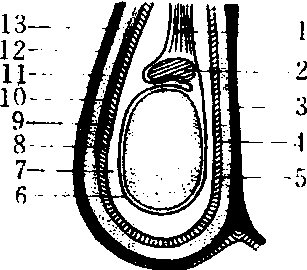阴囊
是一皮肤囊袋,位于阴茎根与会阴部之间。阴囊的皮肤薄而柔软,有少量阴毛,色素沉着明显,颜色深暗,正中是纵行的阴囊缝。阴囊的皮下组织缺乏脂肪而较致密,含有大量平滑肌纤维,称肉膜。肉膜的舒缩可使阴囊松驰或皱缩,这与调节阴囊内的温度有关,有利于精子的发育和生存。在正中线上,肉膜向深部发出阴囊中膜分阴囊为左、右两部,各容纳一侧的睾丸和附睾。
阴囊
男性外阴部的一个袋形物。皮肤薄而富有弹性,能热驰冷缩。借阴囊隔分成左右两囊,每侧有睾丸、附睾及精索,若某种原因使阴囊积液过多,便成为睾丸鞘膜积液;若阴囊与腹腔相通,则可构成交通性鞘膜积液和腹股沟斜疝。
阴囊scrotum
哺乳动物的雄性附属生殖器官。由阴部下垂的皮肤囊形成。内藏睾丸、附睾和精索等。表层的皮肤薄而有弹性,内含许多皮脂腺和汗腺,皮下组织内含有弹性纤维和平滑肌束,暖时松弛,冷时收缩,以调节囊内温度。并在阴囊缝际形成中隔,将阴囊分隔为左、右两个腔。阴囊内壁覆有总鞘膜(鞘膜壁层),并转折覆盖于睾丸及附睾表面,称固有鞘膜(鞘膜脏层)。两者之间围成鞘膜腔,内有少量浆液。鞘膜腔经鞘膜管与腹膜腔相通。如鞘膜管口径扩大,则活动性大的小肠经此管落入鞘膜腔而形成阴囊疝,须手术整复。

阴囊结构
1. 精索 2. 附睾 3.阴囊中隔 4.总鞘膜纤维层 5. 总鞘膜 6.固有鞘膜 7.鞘膜腔 8.总鞘膜 9.总鞘膜纤维层 10.睾外提肌11. 筋膜 12. 内膜 13.皮肤